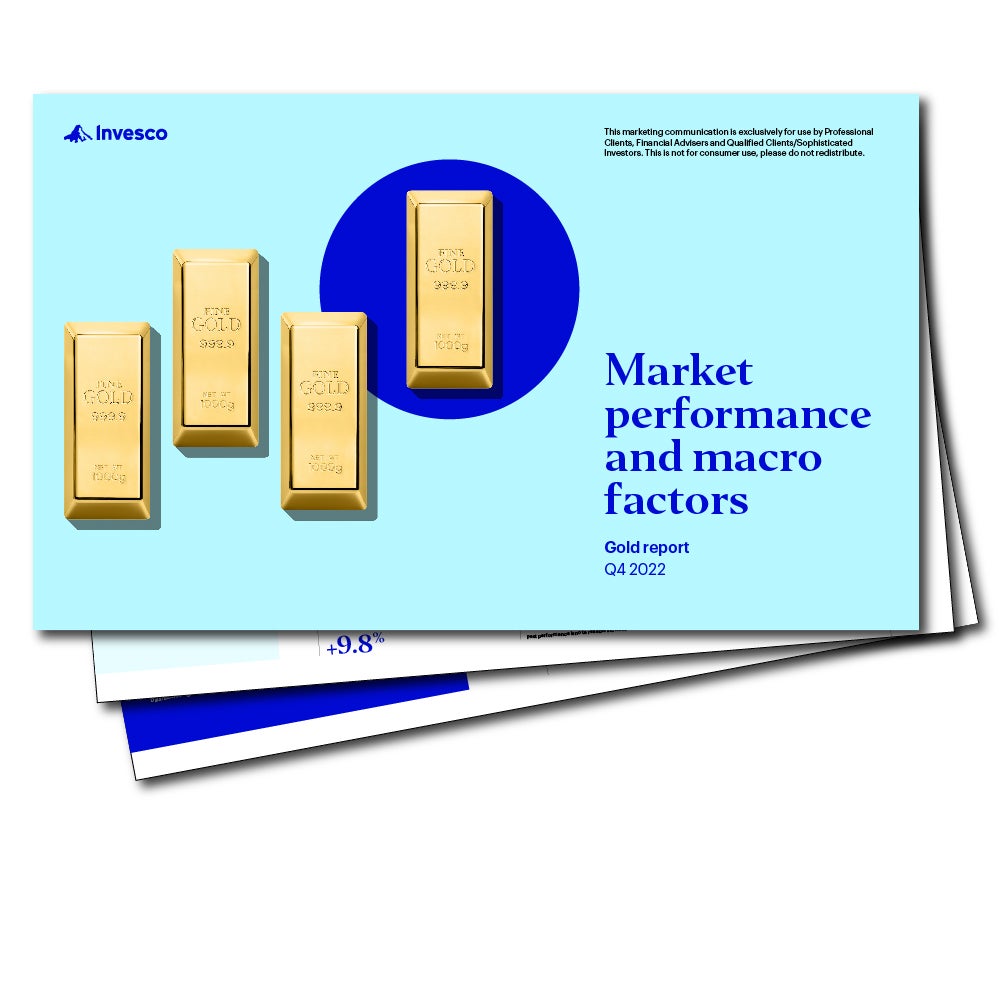
Have you signed up to receive our quarterly Gold Report?
Our quarterly gold report examines the performance of the asset class, macroeconomic factors, and other useful insights. Sign up to receive these insights directly in your mailbox.

The gold price increased by 1.8% in May to end the month at $2,3271, although the metal did set a new all-time high of $2,450 during this time. Reviewing the data, gold reconnected with its traditional drivers of US real yields and US Dollar strength, though support from Chinese purchases and continued heightened geopolitical tensions also helped the gold price.
Source: Bloomberg, as at 3 June 2024. Past performance does not predict future returns.
The gold price hit a new all-time high in early trading on 20 May at $2,450, before investors took profits ultimately leaving the metal $41 higher at the month-end at $2,327. The more hawkish tone from the Fed minutes caused investors to reassess their expectations for the path of rate hikes, but ultimately lower real yields in the US and a weaker USD pushed the gold price 1.8% higher over the course of the month.
Other factors were also at play. Chinese support for gold has been evidenced for several months now with not just the central bank adding to reserves but also at the individual consumer level. Chinese gold prices have traded at a premium for over a year as hedges against a potential devaluation of the renminbi are scoped out. Further turmoil in the Middle East with the death of the Iranian President benefitted gold’s “safe haven” status as speculative traders also added to their net long positions in May. ETFs have not participated in the recent upward trend in the gold price but, perhaps as the traditional drivers come to the fore again, this segment may have a greater interest.
Year-to-date the gold price has increased 12.8%.
Keep an eye on … a period of consolidation before tailwinds reassert.
Source: Bloomberg, as at 3 June 2024. Generic Inflation Index US 10-year government bond or real yield on generic 10-year TIPS (TIPS = Treasury Inflation Protected Security).
US 10-year real yields ended May at 2.1%, 15 basis points lower than at the start of the month. Expectations for stronger revisions to the US Q1 GDP reading were missed, and it is likely at this point that real yields have hit this cycle’s high. This is a positive for gold due to the long-standing negative relationship between real yields and the price of gold, though as service and manufacturing activity remains relatively strong in the US, it may be some weeks before we see real yields break below 2.0%.
The US inflation reading gave the US consumer some relief as the monthly data point was lower than expected, providing the Fed with a greater opportunity to cut rates this year, boosting the price of non-yielding gold. Fed minutes were more hawkish than anticipated providing pushback on those market hopes for a rate cut. PCE inflation data was in line with expectations, but in aggregate the inflation readings showed progress is being made on core inflation with the risk this will not be maintained.
Keep an eye on … continued progress on inflation.
Source: Bloomberg, as at 3 June 2024.
The USD, as measured by the DXY index, lost 1.5% in May, the first monthly loss of the currency so far this year. The dollar fell as markets priced in a greater expectation of Fed rate cuts by year-end albeit still rounding to pricing of a single rate cut with the likelihood remaining that this wouldn’t happen before September. It was this push-back in rates that caused the dollar weakness and supported the appreciation of the gold price.
This was as certainty grew that the ECB would make its first rate cut in June and by year-end the central bank would have made three rate cuts – this was two at the start of May. In the UK, however, markets were less convinced that the Bank of England would be able to make as many cuts as previously estimated, cutting the number of rate cuts in 2024 to one from two and pushing back forecasts for the first rate cut to September from August as anticipated at the start of May. This is as stronger yen has failed to materialise. Despite all these occurrences, it’s still the narrative around a softer dollar on the back of Fed rate cuts that dominates.
Keep an eye on … classic inputs of growth and inflation to determine the direction of US rates impacting USD strength.

Bond Laddering – die Vorteile für Anleger
Obligationenleitern sind Portfolios von Obligationen mit aufeinanderfolgenden Fälligkeitsterminen. Sobald die Obligationen ihre Fälligkeit erreichen, können die Erlöse zur Finanzierung einer bestimmten Ausgabe verwendet werden, beispielsweise zum Sparen für ein Haus oder den Ruhestand, oder in neue Obligationen mit längeren Laufzeiten reinvestiert werden.

Goldangebot und -nachfrage im Q1 2024
In diesem zweiten Teil unseres Goldberichts untersuchen wir die verschiedenen Angebots- und Nachfragequellen, um die jüngsten Bewegungen des Goldpreises genauer zu erläutern.

Monatliches Obligationen-Update
Nach dem Ausverkauf im April war der Mai ein besserer Monat für die Obligationmärkte, mit hohen Zuflüssen von 7,0 Mrd. US-Dollar in Obligationen-ETFs, wodurch die Zuflüsse seit Jahresanfang jetzt bei insgesamt 24,8 Mrd. US-Dollar liegen. Wir geben Ihnen einen detaillierteren Überblick über die Performance der Obligationmärkte und erläutern, was Anleger unserer Ansicht nach kurzfristig besonders im Blick haben sollten.
1The gold price is in US dollars unless stated otherwise in this article.
The value of investments and any income will fluctuate (this may partly be the result of exchange rate fluctuations) and investors may not get back the full amount invested.
Data as at 3 June 2024 unless otherwise stated. Source: Bloomberg.
This is marketing material and not financial advice. It is not intended as a recommendation to buy or sell any particular asset class, security or strategy. Regulatory requirements that require impartiality of investment/investment strategy recommendations are therefore not applicable nor are any prohibitions to trade before publication. Views and opinions are based on current market conditions and are subject to change.
EMEA3628339/2024